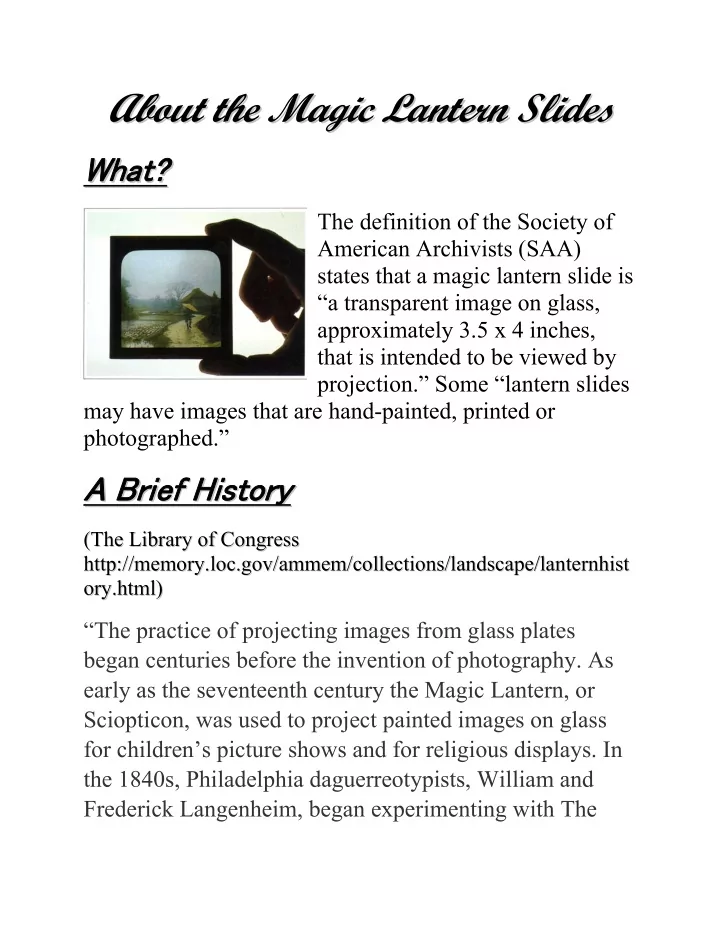

Ab bo ou ut t t th he e M Ma ag gic ic L La an n e ter rn n S Sli lid d es s A t e Wha ? t? What The definition of the Society of American Archivists (SAA) states that a magic lantern slide is “a transparent image on glass, approximately 3.5 x 4 inches, that is intended to be viewed by projection.” Some “lantern slides may have images that are hand-painted, printed or photographed.” A B e H s o y A Br ri ief f Hi ist tor ry (T ( Th he e L Li ib br ra ar ry y o of f C Co on ng gr re es ss s ht tt tp p: :/ // /m me em mo or ry y. .l lo oc c. .g go ov v/ /a am mm me em m/ /c co ol ll le ec ct ti io on ns s/ /l la an nd ds sc ca ap pe e/ /l la an nt te er rn nh hi is st t h or ry y. .h ht tm ml l) ) o “The practice of projecting images from glass plates began centuries before the invention of photography. As early as the seventeenth century the Magic Lantern, or Sciopticon, was used to project painted images on glass for children’s picture shows and for religious displays. In the 1840s, Philadelphia daguerreotypists, William and Frederick Langenheim, began experimenting with The
Magic Lantern as an apparatus for displaying their photographic images. Because of the opaque nature of the daguerreotype, it could not be projected. Therefore, the brothers looked for a medium that would create a transparent image. They employed the discoveries of the French inventor, Niépce de St. Victor, who had discovered a way to adhere a light sensitive solution onto glass for the creation of a negative. By using that negative to print onto another sheet of glass rather than onto paper, the Langenheims were able to create a transparent positive image, suitable for projection. The brothers patented their invention in 1850 and called it a Hyalotype ( hyalo is the Greek word for glass). The following year they received a medal at the Crystal Palace Exposition in London. The Langenheims envisioned their slides as forms of entertainment, charging a fee to watch their picture shows. However, within a few years, lantern slides began to fulfill a variety of purposes. While entertainment
remained an important function well into the twentieth century, lantern slides had the greatest impact on educational lectures, especially in visual disciplines. They played a vital role in the development of disciplines such as art and architectural history, making possible the detailed study of objects and sites from around the world.” La an nt te er rn n S Sl li id de e P Pr ro oj je ec ct to or rs s L For more information The Magic Lantern Society <http://www.magiclantern.org.uk/index.html>
Ab bo ou ut t t th h e M Ma ag g ic c L La an nt r te ern n S Sl li id d s es A e i e In n Japan Japan I The magic lantern slides were introduced to Japan via Holland in the mid 18 th century. They became Japanized and known in the public entertainment media as “utsushi- e” during the late Edo period (1603-1867). However, the educational use of this media began during the early Meiji period (1868-1912), when magic lantern slides were re-introduced by Tejima Seiichi (1849-1918) from the United States in 1874. The Ministry of Education commissioned to two photographers, Tsurubuchi Hatsuz ō and Nakajima Matsuchi, to create the Japanese version of these slides, commonly called "gent ō -ban ( 幻 燈板 )," to promote and educate students and the public. Lantern slides reached their peak popularity in the late Meiji period. During the 10 years before and after the Sino-Japan (1894-1895) and Russo- Japan (1904-1905) Wars, they were especially popular with the major news media.
The popularity of lantern slides among the general public was gradually replaced by cinema. However, they continued to be used at schools as visual media and for prewar propaganda. Even after the World War II, the U.S. occupation forces utilized them for re-education purposes through about 1955.
Recommend
More recommend